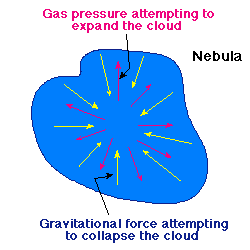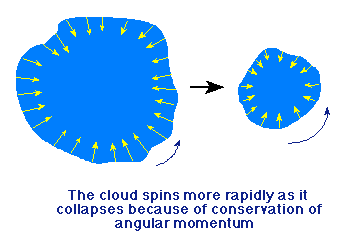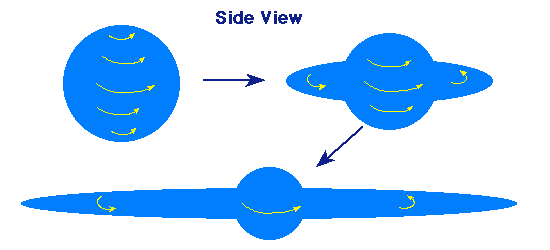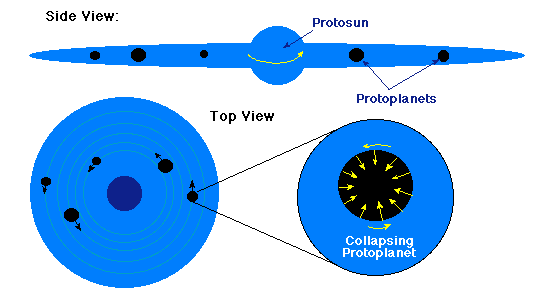 |
 |
| In the Nebular Hypothesis, a cloud of gas and dust collapsed by gravity begins to spin faster because of angular momentum conservation | |
2. Orbits in same plane,
3. For most planets, direction of motion and orbit are same (note peculiarities of Venus, Uranus, Pluto however)
4. Two planetary types: Inner terrestrial planets are high density, Jovian outer planets are low density). Jupiter has liquid metallic core, Uranus and Neptune have slushy core. But these outer planets are all mostly gas. By contrast, the terrestrial planets have rocky mantle and are mostly solid.
5. Planetary ring systems for Jupiter, Saturn, Uranus, Neptune. Also terrestrial planets have fewer moons compared to outer planets.
6. Debris (more than 20,000 ASTEROIDS, many COMETS, many more METEORS), their composition and their orbits. E.g. the asteroid belt between Mars and Jupiter (thought to be failed version of planet formation).
7. Common ages of 4.6 billion years for Earth, moon Mars, meteorites and the sun.
8. The existence of solar systems other than our own (extra-solar planets).
9. The mysterious lack of angular momentum of the sun
10. Composition of solar exterior
We will eventually see how the solar system formation model can explain all these features.
The leading model for the explanation of the formation of the solar system and these resulting features is an EVOLUTIONARY model rather than a CATASTROPHIC model. The former describes a gradual process, while the latter describes an impulsive process. Buffon's PASSING STAR model where a stellar collision strips off matter which eventually forms planets is a catastrophic model. This is ruled out because the gas stripped would would too hot to form planets and also the planets would not like relax into stable orbits upon formation.
In contrast, the evolutionary model called the NEBULAR HYPOTHESIS is much better at explaining the observations. In its original form was proposed by Kant and Laplace in the 18th century. Since then it has incurred many modifications. The initial steps of our modern understanding will be discussed below.
Most all of the heavier atoms were made in stars through nuclear reactions that began 1 billion years after the big bang. (Universe is about 12 billion years old). Cycles and cycles of star formation have occurred since then.
The gas in the galaxy is the result of dying or exploding stars. This gas then gets recycled as new stars form.
The heavy elements in your body like Iron, was formed somewhere in our galaxy, billions of years ago, and only by chance does it happen to be in your blood.
Here is how a solar system forms in summary: Basically, stars form in gravitationally contracting clouds. The center region of a cloud contracts faster and actually forms the star but gas and dust is left orbiting and from this orbiting gas the planets form. When the center of the star becomes hot enough to generate heat by nuclear reactions (fusion) the star lights up and blows away the gas orbiting it, leaving mainly the heavier bodies such as planets.
In the beginning phase A great cloud of gas and dust (called a nebula) begins to collapse because the gravitational forces that would like to collapse it overcome the forces associated with gas pressure that would like to expand it (the initial collapse might be triggered by a variety of perturbations---a supernova blast wave, density waves in spiral galaxies, etc.).
 |
 |
| In the Nebular Hypothesis, a cloud of gas and dust collapsed by gravity begins to spin faster because of angular momentum conservation | |
It is unlikely that such a nebula, or any astrophysical gas collapses with zero angular momentum, thus the gas is probably initially spinning at least slowly. Because of conservation of angular momentum, the cloud spins faster as it contracts.
 |
| The collapsing, spinning nebula begins to flatten into a rotating pancake |
We know the nebular gas would have been mostly hydrogen and we see this in the composition of the solar photo-sphere (outer region of the sun). This is a good check of the theory.
Planets first grow by small bits of solid material sticking together. But the kind of solid material that can form depends on the temperature.
Inner regions of the solar nebula were hotter, thus only the very heaviest material could agglomerate and not disperse. This explains why there is so little hydrogen in the composition of the terrestrial planets and they are largely heavier compounds. Only compounds with high melting points can CONDENSE in the inner regions into solids.
The formation of PLANETESSIMALS occurs by further CONDENSATIONS (atom by atom deposition) onto these initial solid bits. This takes the objects up to centimeter sizes. and then the merging of these solid bits through sticking processes or ACCRETION (rapid accumulation by sticking, static electricity, "snowball effect"). This takes the objects up to kilometer size scales.
Eventually this will drop the heavier material into the plane of the disk, where it will encounter more partners and merging and further interaction, and agglomeration occurs. (Gravitational instability/contraction can further aid growth).
PROTOPLANETS form from the subsequent coalescence of kilometer size bodies. This is aided by the fact that objects are all rotating in the same direction in the disk so their collisions are often gentle (stimulating gravitational merging) rather than destructive (stimulating breaking up into smaller pieces).
Radioactive decay heats internal regions of protoplanets and melts the cores. Then DIFFERENTIATION ensues: the heavier compounds move to the center leaving the lighter materials at the outer regions. It is believed that the atmosphere of our planet was formed as a result of OUT-GASSING (gases released from planetary interior) AND accumulation of some gas from the nebula as it cooled. The need for the latter is because the origin of water is hard to explain otherwise.
Process takes 100 million or so years for terrestrial planets to form
Since the outer planets form in regions of lower temperatures, they are able to hold onto more gas since the gas is cooler and more ices and silicates can coalesce to attract the gas. This is why the outer planets have more light material, that is more gaseous hydrogen: only when protoplanet has more than 15 Earth masses of material can it capture gas directly from the young solar nebula.
It takes about 10 million years for Jovian planets to form: this is based on observations of young stars (T Tauri stars), which have lost their gaseous nebulae by 10 million years.
ASTEROID BELT is explained by Jupiter's gravity thwarting formation of a planet between mars and Jupiter.
We see Jupiter type planets close to other stars not far away as in our solar system. How can this be given the above? Closeness of Jovian type planets around other stars is explained by such a planet capturing many planetessimals and then migrating toward its star from angular momentum conservation.
Venus, Uranus and Pluto's anomalous spins explained by impulsive collision with massive object. Craters tell us there were many collisions, but usually small objects. Perhaps a few were large enough to explain the anomalous rotations of these planets.
Eventually, 4 effects clear away the nebula: the Sun's radiation pressure, the solar wind, the gravitation of the individual planets, and close encounters between planets and planetessimals.
METEORS, COMETS, ASTEROIDS are left as residues of the planet formation process.
 |
| As the nebula collapses further, local regions begin to contract gravitationally on their own because of instabilities in the collapsing, rotating cloud |
While they are still condensing, the incipient Sun and planets are called the protosun and protoplanets, respectively.
The nebular hypothesis explains many of the basic features of the Solar System, but we still do not understand fully how all the details are accounted for by this hypothesis. As we discuss in the next section, we now have some direct observational evidence in support of the nebular hypothesis.